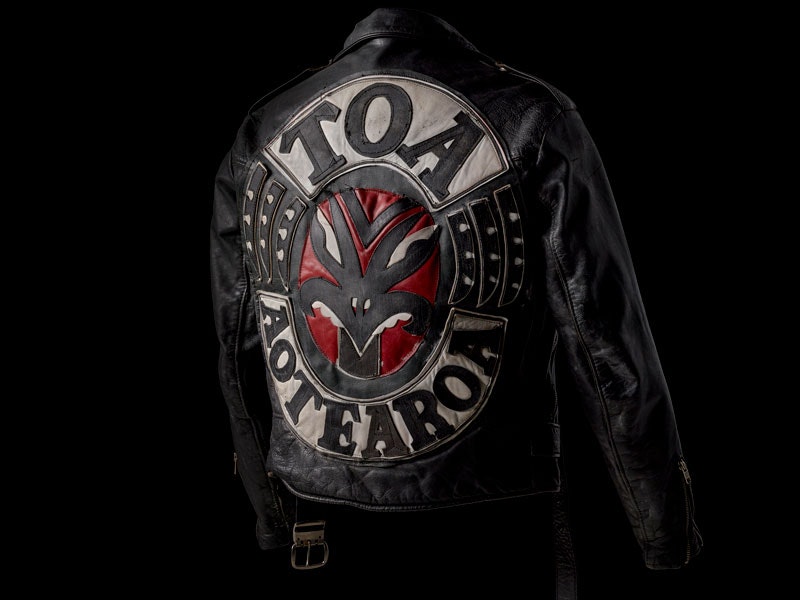
Curators' Choice: 21 Things
From chess to safe sex, silverware to gang wear – what do we collect? And why? Explore 21 new collection items. Discover our curators’ thinking.
Closed
14 Dec 2019 – 13 Jun 2021
Exhibition Ngā whakaaturanga
Free museum entry for New Zealanders and people living in New Zealand
Open every day 10am-6pm
(except Christmas Day)
Free museum entry for New Zealanders and people living in New Zealand
A gang patch jacket from the 1994 film Once Were Warriors will feature in Kei te Kairauhī: 21 ngā Taonga | Curators’ Choice: 21 Things; a mini exhibition exploring how and why Te Papa curators collect.
Featuring 21 recent additions to the collection, this exhibition opening on 13 December will shed light on the innovative ways in which Te Papa builds its collections for generations to come.
Jacket, Once Were Warriors, 1994. Design by Michael Kane and Pauline Pohatu. Leather, paint, metal. Purchased 2017. Te Papa (ME024268)
The exhibition items on display have been acquired over the past two years and range from digital material to handcrafted objects, spanning the early 1880s to the present day. Each acquisition has been collected by Te Papa curators through various different platforms including auction houses and co-collecting projects.
Stephanie Gibson, Curator New Zealand Histories & Cultures, says Curators’ Choice: 21 Things will provide an interesting perspective on how Te Papa sources precious items for the national collection as a way of preserving New Zealand’s culture, past and present.
“This mini exhibition will intrigue visitors while providing insight into a core part of what Te Papa does as a museum,” Gibson says.
A unique example of collecting is highlighted through the display of internationally acclaimed Pacific couture fashion designer Lindah Lepou’s Wild Victorian. This Invercargill-based designer intended to burn her fashion archive to let go of the past and start anew, prompting curators at Te Papa to work with her to save the garment and acquire it for the national collection in 2017.
Wild Victorian, 2005, by Lindah Lepou, pandanus, cotton drill with metal fastenings. Te Papa (FE013157)
Lepou created Wild Victorian as a representation of female strength, her identity as fa'afāfine and the intertwining of her two heritages: Pākehā and Sāmoan.
This mini exhibition also acknowledges the breakthrough moment in Māori film-making with the display of the Once Were Warriors jacket. This hard-hitting film was an important milestone for conversations centred around Māori representation on screen and the patched jacket, for the fictional TOA Aotearoa gang, provides a focus for discussion on gang culture and identity within New Zealand.
Further items on display in Curators’ Choice: 21 Things include Auckland-based studio portraits from the 1880s, a 1970 ‘Discovery of New Zealand’ chess set, safer sex posters made in the 1990s, and a number of other collection items which represent New Zealand’s culture in its many dimensions.
Curators’ Choice: 21 Things | Kei te Kairauhī: 21 ngā Taonga
Opening on 13 December 2019 - September 2020
Mini exhibition, entry is free
Located on Level 3
Allow 15 minutes
Ends
Wild Victorian, 2005, by Lindah Lepou, pandanus, cotton drill with metal fastenings. Te Papa (FE013157)
Radiating dish, 1980s, by Ruth Castle, rattan, dyed with potassium permanganate. Te Papa (2019-0010-1)
Once Were Warriors leather jacket, 1994, by Pauline Pohatu and Michael Kane, leather and paint. Te Papa (ME024268)
Couple with a baby, 1890s, by John Carduff Morton, photograph, cabinet card. Gift of Alan Gibson, 2017. Te Papa (O.045063)
Kawana brooch, circa 2016, by Matthew McIntyre-Wilson, copper and nickel alloy. Te Papa (ME024280)
Kahikiku Aloha Shirt with Hīna'i design, 2017, by Kealopiko, screen print on organic cotton. Te Papa (FE013067)
Wild Victorian 2005
By Lindah Lepou, Sāmoa/New Zealand
Jacket, Once Were Warriors 1994
Design by Michael Kane and Pauline Pohatu, Ngāi Tāmanuhiri tribe, New Zealand
Kahikikū Aloha Shirt with Hīnaʻi design 2017
By Kealopiko (Ane Bakutis, Jamie Makasobe, Hina Kneubuhl), Hawai‘i
The Discovery of New Zealand Chess Set 1970
By Frank Szirmay (1916–86), Hungary/New Zealand, commissioned by Riki Creative Art Limited, New Zealand
Placard, Women’s March 2017
By members of Women’s March on Washington – Wellington, New Zealand
Cliff Whiting with ‘Aoraki’, October 1987
By Laurence Aberhart (1949–), New Zealand
Radiating dish 1980s
By Ruth Castle (1931–), New Zealand
Sunflower dish 1980s
By Ruth Castle (1931–), New Zealand
Check dish 1980s
By Ruth Castle (1931–), New Zealand
Poster, ‘Queens of the Pacific’ late 1990s
Design by Arjan Hoeflak, photography by Mariano Vivanco, published by New Zealand AIDS Foundation
Poster, ‘Like Our Ancestors’ 1998
Concept by Harold Samu, design by Arjan Hoeflak, photography by Mariano Vivanco, published by New Zealand AIDS Foundation
Brooch, diamond starburst 1902
Attributed to Frank Hyams, New Zealand/Britain
Brooches, Kawana about 2016 and Kuini 2017
By Matthew McIntyre-Wilson (1973–), Ngā Māhanga tribe, New Zealand
Snuff box (for powdered tobacco) about 1890
By Frank Hyams, New Zealand/Britain
Cigarette box 1903
By Frank Hyams, New Zealand/Britain
Knife rests 1890s
By Frank Grady (1840–1915), Britain/New Zealand
Couple with a baby 1890s
Man 1875–85
Woman 1885–89
Man wearing a hat 1882–84
By John Carduff Morton, Hemus & Hanna, John Robert Hanna, and Partington & Kinsey, New Zealand
F Mitchell, Auckland, New Zealand 1880s
Woman 1886–88
Man 1880s
Woman 1880s
By Robert Henry Bartlett, George Gregory, and Josiah Martin
Drone footage of Atafu, Fakaofo, and Nukunonu atolls (extracts) 2017
By Andrew Matautia (1984–) Sāmoa/New Zealand
The dialogue of Tītokowaru and Socrates 2010
From the series ‘Tītokowaru’s Dilemma’
By Marian Maguire (1962–), New Zealand
Socrates and Tītokowaru discuss the question, ‘What is virtue?’ 2009–10
From the series ‘Tītokowaru’s Dilemma’
By Marian Maguire (1962–), New Zealand
Clare Callaghan, Communications Advisor
clare.callaghan@tepapa.govt.nz
021 541 343

From chess to safe sex, silverware to gang wear – what do we collect? And why? Explore 21 new collection items. Discover our curators’ thinking.
Closed
14 Dec 2019 – 13 Jun 2021
Exhibition Ngā whakaaturanga